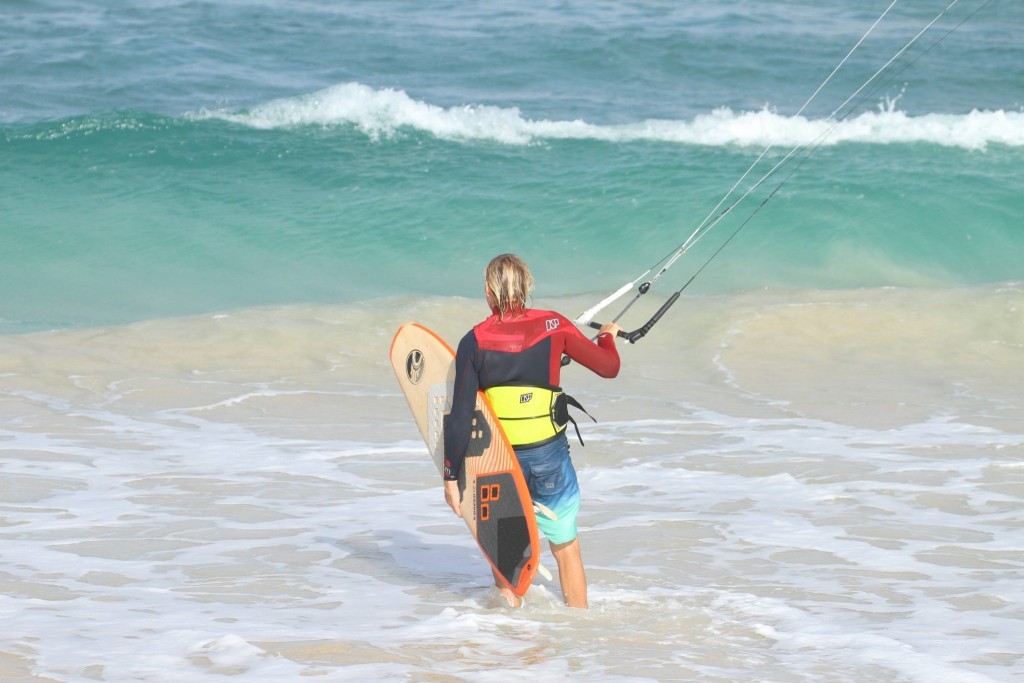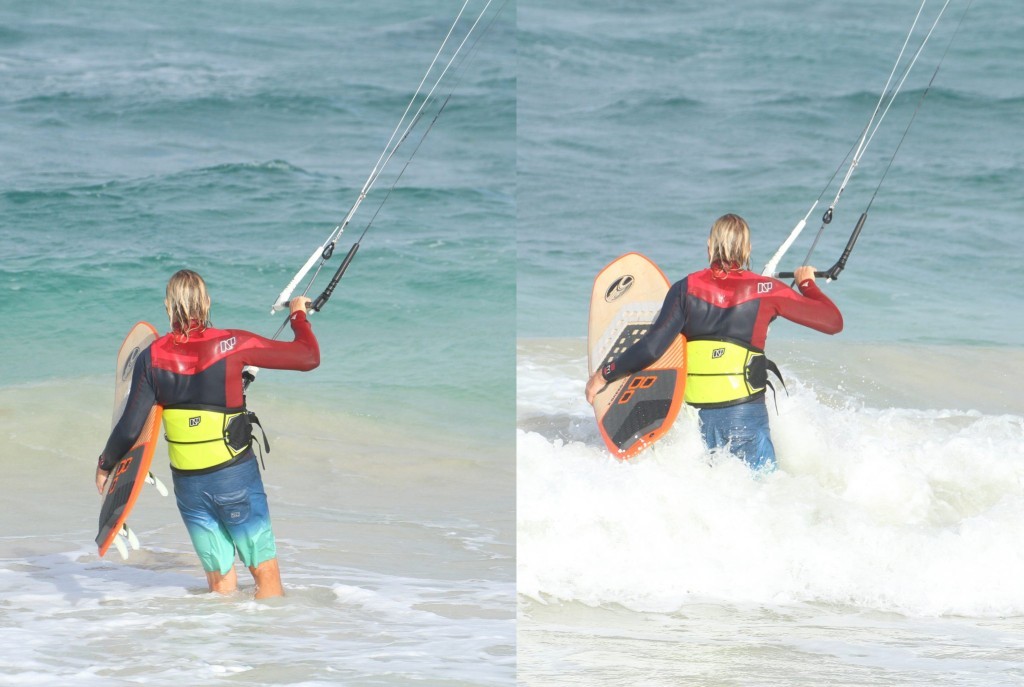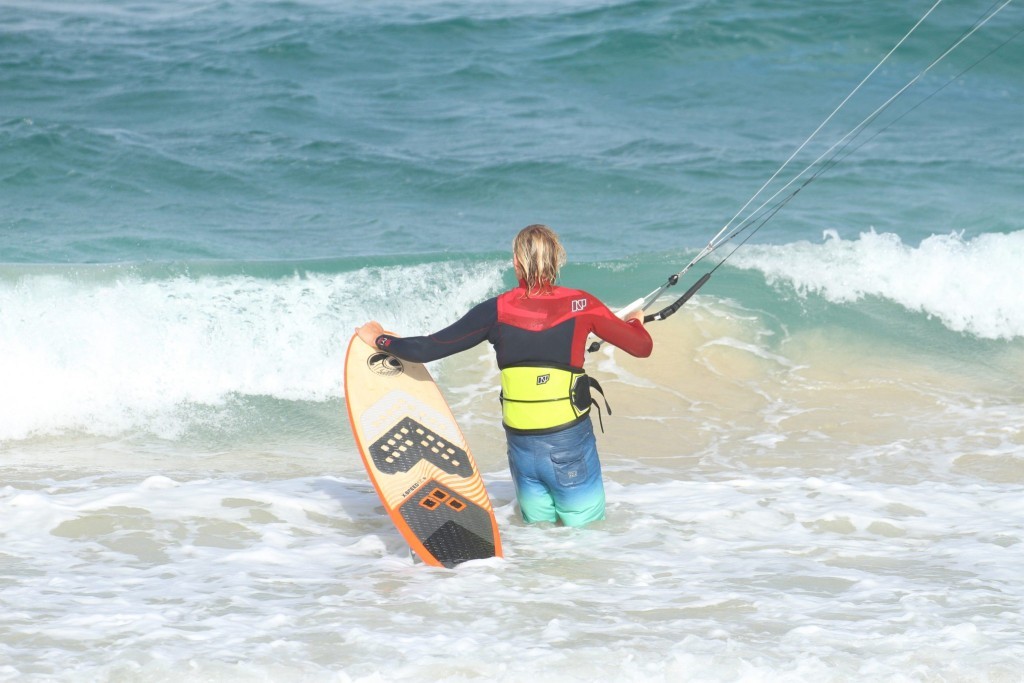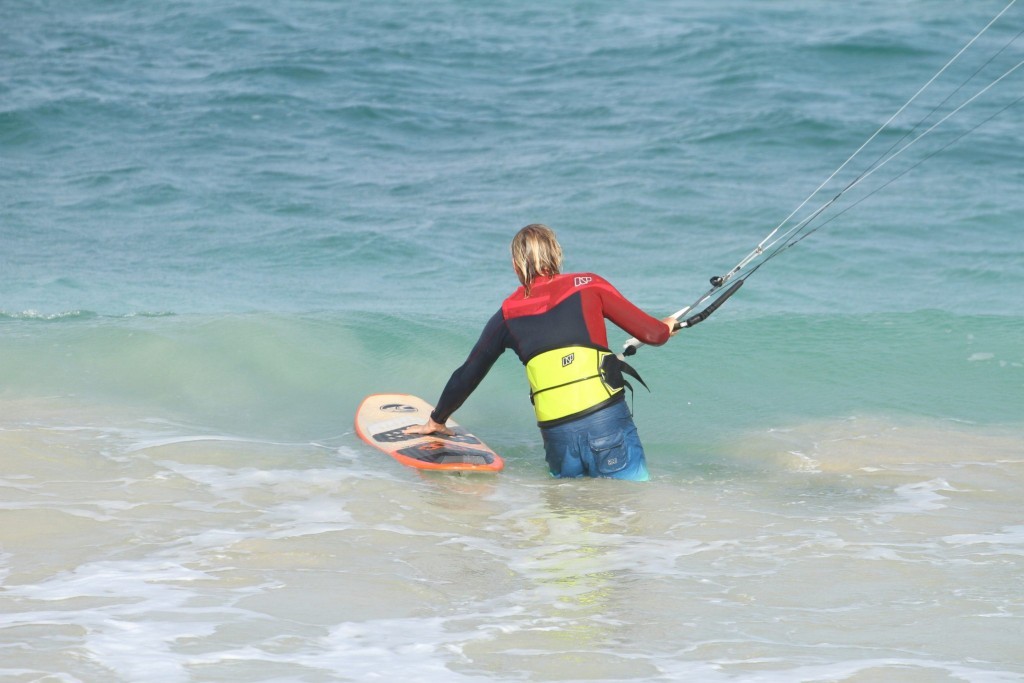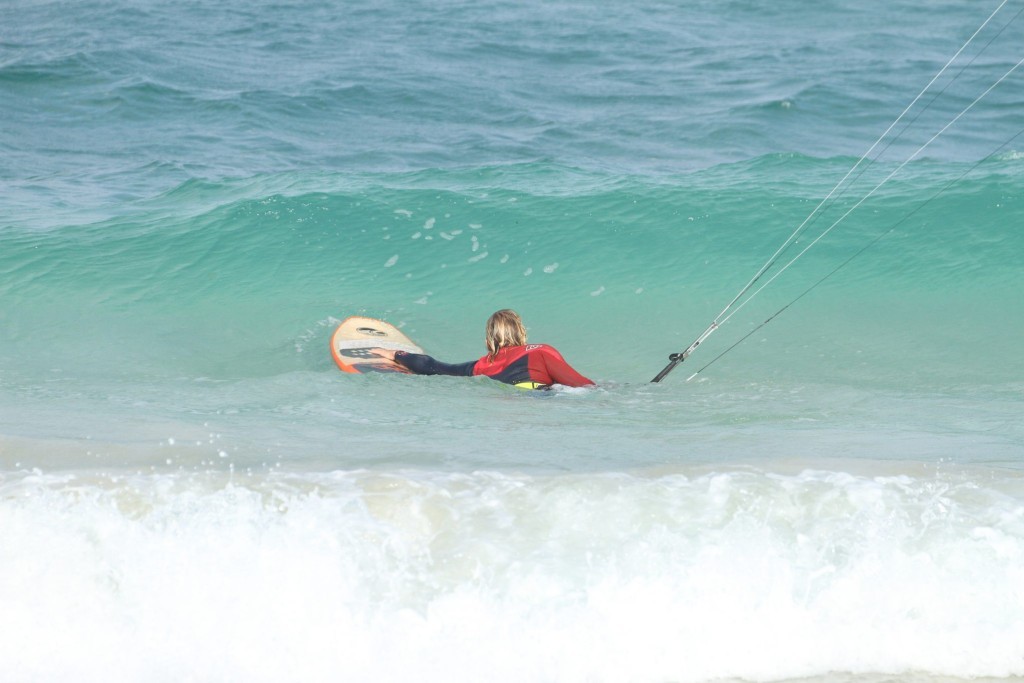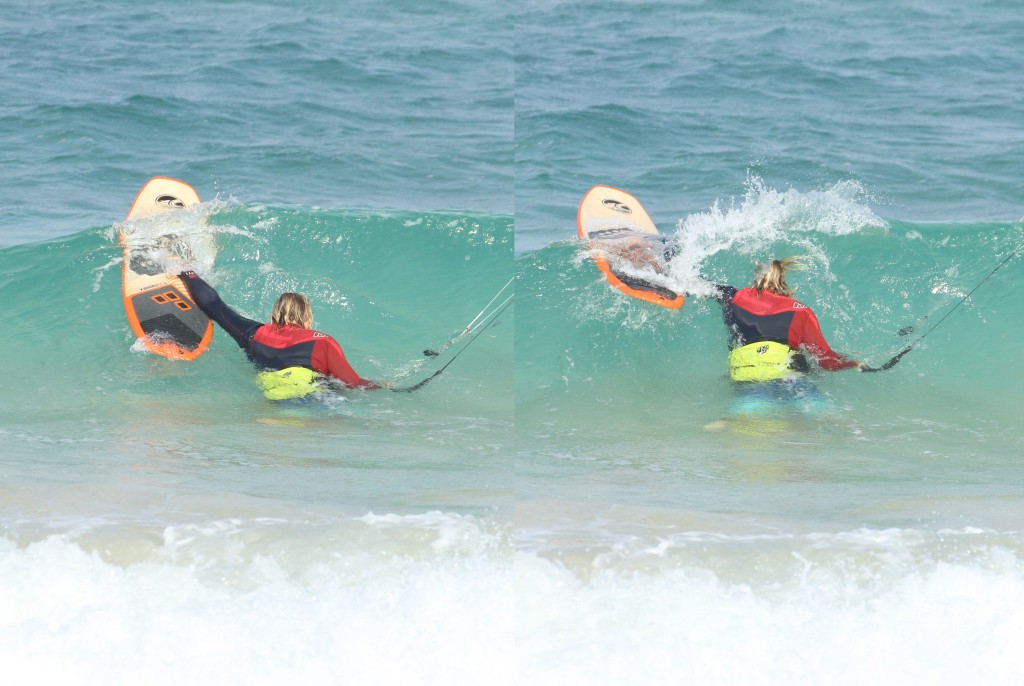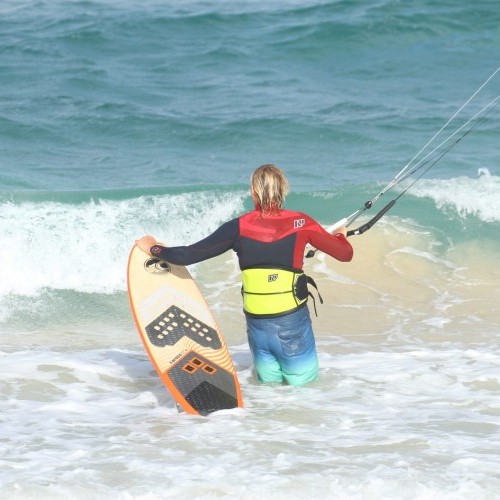
Body Dragging Past the Shorebreak on a Surfboard
Technique / Intermediate
Introduction
Unless you’re Olympic quick at beach starting and an absolute legend at getting over waves, body dragging out to calmer waters is never a bad idea, regardless whether you’re on a twin tip or a surfboard. So often one witnesses frustrated kiters who are constantly getting washed back up the beach, getting knocked off their boards before they’ve managed to water start, or being wiped out by a sandy coloured wave just metres from the shore.
To be honest we’ve all been there. Many years back there was a memorable BKSA competition in Brighton, where many heats were won by those who managed to get out and actually compete. Those who did, did so by swallowing their pride and dragging out. Dragging 10 or 20 metres off shore may not be the height of cool, which may prevent many from doing it, but neither is the unevenly matched, energy sapping and potentially kite and body breaking game of ping-pong between yourself and the rather more skilled and capable shore break! The great news is that if you can body drag upwind you can body drag away from the beach...
Before we crack on it is worth pondering one incontrovertible truth. If the wind is blowing directly onshore, you may well struggle. It’s just the nature of the beast. In this case you’re best to look for another part of the beach or a different beach where the wind has a little cross in the on.
In our example here, we have cross-on wind, blowing from left to right across the photos and a small but still skilful shore break with calmer water about 15 metres out.
The Same Way Pic A.
It’s always best to state the obvious which is oft forgotten. If Christian had lost his board, then walked up the beach to body drag back out to it, he would of course control the kite with his back hand and use his front arm for resistance. When you have a board the princaples remain very much the same. However, many kiters will prefer to carry the board out under their back arm, in the belief, quite correctly, that the board will not end up between themselves and the waves and therefore they’re less likely to get clobbered by it.
However there comes a time when you need to switch hands, and this is the time when it all too often goes pear shaped. You can happily hold the board with your front arm, control the kite with your back hand, and remain out of harm’s way if you walk into the water facing forwards, rather than crabbing sideways. This has the added bonus of giving you a good view of what is coming, so that you can time your escape form the beach during the moment of least shore-break. You can see here that by having the board under his front arm and twisting to face forwards Christian can actually carry the board behind him, with no risk of getting it smacked into him by an oncoming wave.
While walking out, don’t forget your kite. You want it parked somewhere between 45 degrees and either 1 or 11 o’clock, depending on which way you’re going. Having the kite out to sea will help you walk and resist the force of the waves, but you need it high enough that there is room for error, should you get washed in.
The Walk Out – Harness Method Pic B.
There are a few options for walking out with the board, and this is certainly an easy one if the water doesn’t get deep too quickly. As long as your board isn’t too wide, or your arms are sufficiently long this one requires very little strength. Good for a long walk and a gently shelving beach as it’s easy to keep the board high and carry it over small waves. Christian has the board under his front arm, and the rail nearest him is pulled up into his armpit, above his harness. This means that when a wave approaches he can lift his arm, using the edge of his harness to lever the board up. While walking, look out to sea to see what’s coming. There’s no point watching the shore break close in, you want to know what’s in the post.
Twin tip riders should use the handle, or if it’s “missing”, use the front strap.
The Walk Out – Nose Method Pic C.
Another winning method here, which allows waves to pass under your board, and which has the added bonus of the best quick release if you lose control after a wave hits. Grab the board either on the nose, or on the side of the nose furthest from you, hold it up and walk out. As waves pass, the tail will lift and drop of its own accord. If for whatever reason you get into trouble you can just let go and the board will wash in behind you, with no risk of you getting cracked by it. This method also works great with a twin tip.
The Walk Out – Push Pic D.
This is the ultimate way to end your walk out into the sea. You can do this from the very beginning once it’s deep enough for your fins if you don’t mind bending down, otherwise once you’re waist deep this makes perfect sense as you’re then primed and ready to go. By placing your front hand on the front pad, or where your front foot would normally go, you’ll have plenty of purchase to push the board out.
As the board will be leading, keep it at arm’s length out to one side. This way you still have the option to release it without any consequences and it will once again wash in behind you. To get it over waves or white water lean more of your body weight on it so that you can forcefully push it out to sea. The beauty here is that as the water gets deeper you can easily transition into your body dragging position.
Body Dragging Pic E.
As you guessed, this is an extension of pushing the board out. Your intention is not to get over the board and bury the rail to get maximum upwind propulsion. A fine idea if there’s just a few wavelets, but as soon as there is breaking shore break, this will potentially put the board up-wave of you, and we don’t want that! In the photo Christian is moving the kite with his back hand as per usual for a body drag, while keeping his front hand pressed down on the front pad. Having your front hand forwards on a directional board is not a problem, as even if the kite pulls you slightly off the wind, the board will follow as it pivots around the fins at the back. Christian’s direction of travel is diagonally out from the beach, while the board is held as far out upwind of him as possible. Once again there’s the option of letting go if you lose control.
The Inevitable Pic F.
Should you encounter a wave on the way out, it will really depend where you are relative to it whether you can get the board and yourself over it or whether you’ll have to go through it. Both are possible only with pull from the kite, so when you see something coming make sure that the kite and yourself are moving, you towards it and the kite already over the other side, which will help pull you past it. Here Christian is just where the wave is about to break. If it was a tiny bit further out he could just drag over it, pushing down on the board whilst raising the kite slightly to lift him.
However, as the wave is pitching he chooses to keep the kite a bit lower, push down on the board to push the nose under the wave, following with his head and shoulders, diving through the wave. All the time, keeping the board at arm’s reach and himself out of harms way. If the worse comes to the worse he’ll lose the board, but he and the kite will remain intact.
Once you’re through keep going until you know that you’re beyond where the shorebreak jacks up. If in doubt keep body dragging, better too far out than not quite enough. Once happy, it’s feet on the board and off you go.
Top Tips
Body dragging out is also about timing, and never is it truer that patience is a virtue. Sometimes you might wait for a few minutes for the perfect opportunity. This time can be well spent, watching the way the shorebreak works and where it pitches. You may spot an easier point of entry, or you might realise that it looks a bit daunting.
Have a look at the sequence and videos for the full walk through.
Common Problems
As mentioned earlier, the majority of problems arise from controlling the kite with the front hand while holding the board with the back hand. As long as you face forwards the preferred and usual method is just as safe.
If you feel that you’re not getting anywhere, it likely means that you need more power. The only way to generate more power is to move the kite, so get the kite moving up and down with your back hand so that it pulls you more.
Not going far enough. There’s nothing more frustrating than beating the shore break and then it getting one back on you because you didn’t go quite far enough. Once you’ve stopped and start to put the board on, you’re pretty much facing the beach, so you won’t see what’s coming. At the very least be quick.
Keystones
- Board in front hand, bar in back hand
- Walk in slowly watching the waves
- Push board once past waist deep
- Drag through keeping kite low enough to pull, high enough to stay out of trouble
- Go further than you think, just to be sure....
This technique article was in Issue 74 of IKSURFMAG.
Related
By Christian and Karine
Christian and Karine have been working together as a coaching team, running improver to advanced kitesurfing clinics since 2003.






